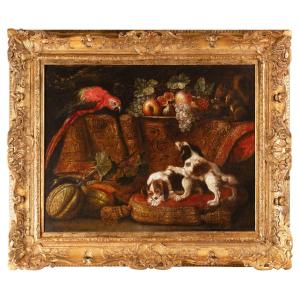Attributed to Reynaud LEVIEUX (Nîmes, 1613 – Rome, 1690)
17th century French School
Oil on canvas, dimensions: h. 67 cm, l. 87 cm
Louis XIV period giltwood frame 18th century
Dimensions with frame: h. 95 cm, l. 115 cm
Like a magic trick, the illusionist power of our painter reveals to us a baroque world where in a theatrical setting, the southern light exalts the colors and materials.
In the opulence and extravagance of this exhibition, the tight framing propels forward the earthly beauties against a luxurious background of precious dyes created by the hand of man.
The tray laden with fruit is placed on an entablature covered with a sumptuous Persian carpet in shimmering colors. Offering figs, bunches of grapes, apples and burst pomegranate, it transports us to the south of France. A Macaw with red feathers seem to watch over the contents and courageously confront two small toy spaniels installed on a luxurious red velvet cushion generously embroidered with gold threads and decorated with pompoms. Captivated by this tense atmosphere, we barely see another intruder: a squirrel quietly nibbling a bunch of grapes.
On the left in the foreground our eye is immediately drawn to two melons, one of which is half-open and ripe. The realistic rendering of his skin with its bumpy texture awakens our sense of touch, it seems that this rough surface created thanks to generous serifs can break the canvas, like a fruit ready to burst.
Scattered warm lighting creating chiaroscuro betrays the Italian influence. This is how fruits and animals emerge from the darkness with aesthetic force and a three-dimensional appearance.
Our work is a variant of the lost composition of Reynaud Levieux known through replicas and its publication in the catalog of Jean Wytenhove Reynaud Levieux and classical painting in Provence (Aix-en-Provence, 1990, p. 58, repr.), our painting wonderfully illustrates the fame of this composition in its time.
Related works by Reynaud Levieux:
• Still life – fruit, parrot, dogs and squirrel, Villa Vauban, Luxembourg City Art Museum, oil on canvas, sizes unknown.
• Parrot confronting two spaniels on a trimmings cushion, oil on canvas, 76.2 x 96 cm, Christie's Paris, 12/19/2007, lot 489
• Still life with spaniel, oil on canvas, 75 x 90 cm, Inv .: L.83.2, Musée des Beaux-Arts de Marseille
Reynaud Levieux, known above all for his religious production imbued with an austere classicism inherited from Raphael and Correggio, his model painters, produced during his long career subtle still lifes intended for a clientele of amateurs and the ornamentation of private mansions. This aspect of his production is less known today, and is an essential milestone for better understanding the talent he displays in this genre. As evidenced by his paintings, the painter was greatly influenced by the Italian master of the Roman Baroque still life Franceso Noletti or Fieravino active in Rome between 1636 and 1654, the period of Reynaud Levieux's first stay in Rome.
This period corresponds to a turning point in the art of Italian still life.
The first Italian still lifes, around 1600, are meticulous and precise, often with symbolic meanings, linked to religion, the vanity of earthly foods, and the transience of life. A few decades later, Italian still life adopted the baroque style, which suited it wonderfully: it always sought illusion, the faithful rendering of materials, but in abundance, heaps and luxury. Having become a decorative object, it gains in virtuosity and ease what it loses in spirituality.
Reynaud LEVIEUX (Nîmes, 1613 – Rome, 1690)
Son of a glass painter, Protestant from Uzès, settled around 1612 in Nîmes, Reynaud Levieux was born on January 6, 1613.
After initial training in his father's workshop, of whom he will always keep the taste for smooth, contrasting painting and impeccable technique, he left for Rome in 1635.
He was part of a team of six painters with Pierre Mignard, Jean le Maire, Charles Errard, Jean Nocret and Nicolas Chaperon.
Under the direction of Nicolas Poussin, he copied Raphaël - two painters who would have a profound impact on him.
His paintings from this period are not all known and we are beginning to discover them, sometimes hidden under illustrious names, such as Theseus discovering his father's arms which was attributed to Laurent de La Hyre.
He returned to Nîmes in 1645 and then settled in Montpellier in 1649, he participated in the decoration of the Hôtel d'Autheville, and created tapestry cartoons on the theme of the Life of Moses.
Then established in Avignon, in 1651 he painted a Holy Family for the Carthusians (collegiate church of Villeneuve-lès-Avignon); he painted the Purification of the Virgin (1654) for Notre-Dame-des-Doms. In 1659 he joined the brotherhood of Black Penitents, for whom he painted a Deposition of Saint John the Baptist (Nîmes museum).
He painted numerous paintings for private mansions and in particular his famous still lifes where we find his favorite animals, spaniels and parrots, sometimes squirrels. There are several more or less detailed versions with the addition of fruits or flowers and in different formats.
In 1669, Reynaud Levieux left for Rome where he resided for the rest of his life for thirty years while he continued to paint and send his paintings to Provence. Reynaud Levieux died on March 18, 1699 and was buried the next day in the church of Sainte Marie-des-Anges (Santa Maria degli Angeli) in Rome.
Bibliography:
Henri Wytenhove, Reynaud Levieux, Aix en Provence, 1990, p. 58












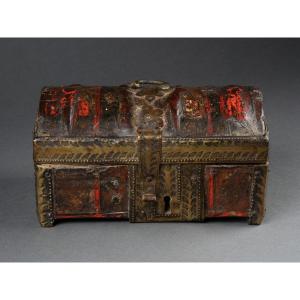
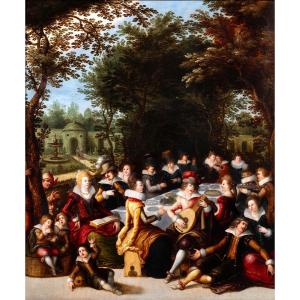

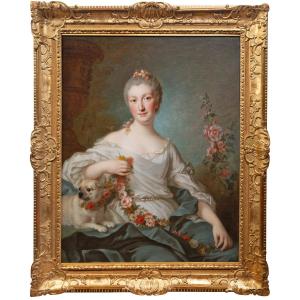
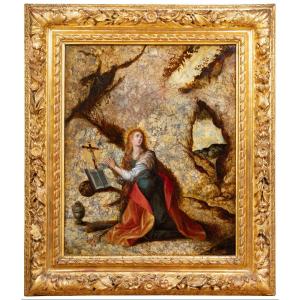





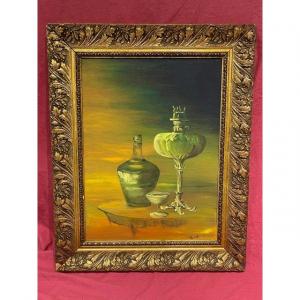
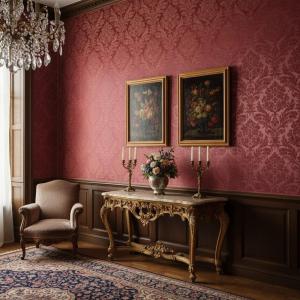




 Le Magazine de PROANTIC
Le Magazine de PROANTIC TRÉSORS Magazine
TRÉSORS Magazine Rivista Artiquariato
Rivista Artiquariato
